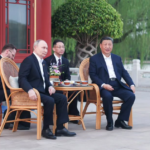Honouring a secret deal, Congress Prime Minister P. V. Narasimha Rao was a front foot participant in the building of the makeshift Shri Ram Janmabhoomi Temple after the demolition of Babri structure (The Babri Masjid was a mosque in Ayodhya, India, that was the subject of a dispute between Hindus and Muslims for many years)

The clandestine pact between top Hindu leadership and the Congress Prime Minister happened because both sides desperately needed each other. Narasimha Rao was running a minority government in 1992. He had been chosen in the top job by Sonia Gandhi, hoping that the old and frail man will be more pliable than anyone else. However, this proved to be a grave miscalculation.
Well before the demolition of the Babri structure, the Vishwa Hindu Parishad (VHP) had calculated correctly that the moment the demolition is accomplished, BJP’s Chief Minister Kalyan Singh’s government in Uttar Pradesh will be dismissed. This made the situation too complicated for the next step.
Dismissal of Kalyan Singh clearly meant imposition of central rule. Meaning Narasimha Rao (read Central Govt) will be responsible for running Uttar Pradesh. It was difficult to daydream that a Congress Prime Minister would let the Kar Seva continue for 36 hours after demolition, that is until a makeshift Temple was ready, and the idols of lord Ram re-installed in the newly built shrine.
The most logical scenario after demolition was immediate takeover of the site by the Central forces, and imposition of status quo until the judicial verdict.

Leaving a blank site was, legally, a big complication. Hindus and Muslims would have fought over the sacred area. It would have been a grey zone.
Hindu leadership came up with a brainwave. They understood that Narasimha Rao needed to feel secure in his position, even without a majority. The BJP had 119 seats in that Lok Sabha in 1992.
In the pact between the Hindu leadership and Narasimha Rao, a barter deal was agreed upon. According to arrangement, after the demolition was over by the evening of 6th December1992, VHP and Durga Vahini will continue the Kar Seva till the time a makeshift Lord Ram Mandir was established. In return, the VHP promised that the BJP’s 119 Lok Sabha MPs will stand guarantee that Narasimha Rao’s minority government is not forced to fall.

In the words of one of the senior-most Hindu leaders present in the confidential huddle: ‘जब तक आल इण्डिया इंस्टीट्यूट ऑफ़ मेडिकल साइंसेज के डाक्टर आप को ब्रेन डेड घोषित न कर दें, तब तक आप की कुर्सी के चारों पाए पकड़ कर हम बैठे रहेंगे। आप की सरकार को गिरने नहीं देंगे।‘ (We will remain sitting holding the four legs of your chair until the doctors of All India Institute of Medical Sciences declare you brain dead. Will not let your government fall.)
This deal was profitable for both sides and agreed upon solemnly by both. The rest is history as we know it. On the 6th December 1992, Babri structure was demolished between 12 noon and 6 p.m. With the felling of the last dome, Kalyan Singh resigned. So did the other three BJP state governments.
The Kar Sevaks picked up one brick each and cleared the debris efficiently. Now began the building of the makeshift Temple. While the act of demolition took only 6 hours, the act of building the small Temple took 36 hours.
Those 36 hours were heart-rending for the Muslims. “Secular” politicians and intellectuals tried to reach out to Narasimha Rao to ask him to stop the construction. Narasimha Rao was unavailable due to “ill health”. He was said to be sleeping.
So, through the evening of the 6th December 1992, and through the morning, afternoon, evening and night of the 7th December, until 8 a.m. of the 8th December, the work on the Temple was performed unhindered. The Central forces were present in Ayodhya, but they were reportedly not instructed to act by the Centre. After the idols were safely placed in the Sanctum Sanctorum, Narasimha Rao suddenly became active and put a stop to any further activity.
It is only a hypothetical question whether the Supreme Court would ever have been able to order demolition of Babri Structure, in order to build the Grand Ram Temple as it stands toda? It was far easier for the Supreme Court to pronounce its verdict, because no masjid structure stood on the “disputed” site. It was easier to convert a small temple into a Grand Temple.
Narasimha Rao had honourably kept his word and duly received his part of the bargain. After seven months and 20 days, on the 28th of July 1993, Narasimha Rao survived the no-confidence motion in Lok Sabha and cobbled up a majority for the first time during his tenure.
The Hon’ble Supreme Court Judgement on Babri Masjid on November 9, 2019
Given the political and highly contestable nature of the Ayodhya conflict, the November 9 unanimous verdict by a five-judge constitution bench, consisting of Chief Justice of India Ranjan Gogoi, CJI-designate S.A. Bobde and Justices D.Y. Chandrachud, Ashok Bhushan and S. Abdul Nazeer, has expectedly generated contrasting opinions. The bench ruled that the entire 2.77 acres of disputed land in Ayodhya be handed over to a trust to be constituted for the construction of the Ram temple at the site, and five acres allotted at a ‘prominent site’ in Ayodhya to build a mosque.


























































